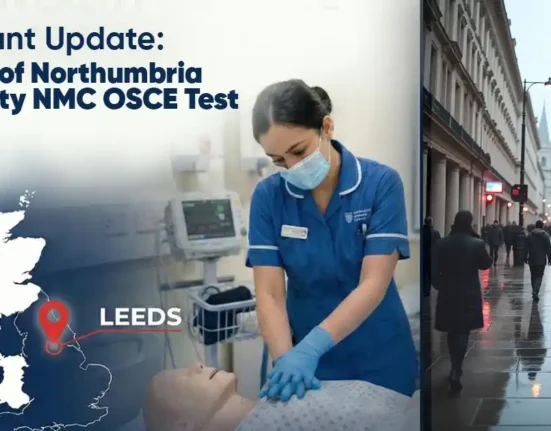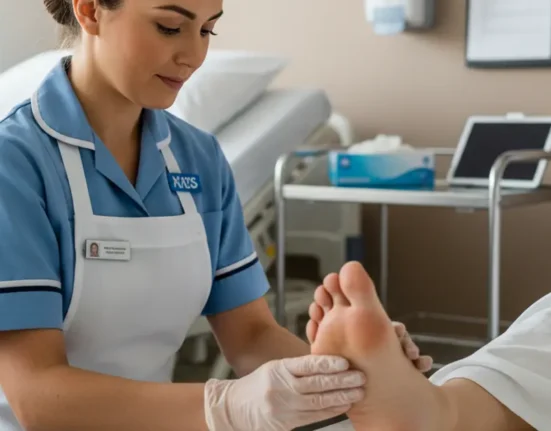Table of Contents
In healthcare, patient monitoring plays a crucial role in ensuring early detection of deterioration and preventing adverse outcomes. Two essential tools used in NMC OSCE clinical practice for this purpose are the National Early Warning Score (NEWS) and the Observation Chart. This article explores the differences between NEWS and Observation Chart, their significance, and how they contribute to patient care.
What is NMC OSCE NEWS (National Early Warning Score)?
The National Early Warning Score (NEWS) is a standardized scoring system designed to assess a patient’s risk of deterioration. It is widely used in hospitals to help healthcare professionals identify early signs of clinical deterioration and take appropriate action.
Key Features of NMC OSCE NEWS Chart:
- Scoring System: NMC OSCE NEWS denote six physiological parameters:
- Respiratory rate
- Oxygen saturation (SpO2)
- Temperature
- Blood pressure
- Pulse rate
- Level of consciousness (AVPU scale: Alert, Voice, Pain, Unresponsive)
- Risk Stratification:
- Score (0): Routine monitoring (12 hourly)
- Score (1-4): Monitor 4-6 hourly
- Score (5-6): Increased frequency of monitoring 1Hourly
- Score (≥7): Urgent medical attention and Continuous monitoring
- Standardization: NMC OSCE NEWS chart provides a uniform approach to identifying patient deterioration across all healthcare settings.
- Clinical Response: Based on the total NEWS score, healthcare professionals follow a structured response pathway, ensuring timely intervention.
Check out our guide on How to Document an Observation Chart in NMC OSCE Exam: A Comprehensive Guide !
What is NMC OSCE Observation Chart?
NMC OSCE Observation Chart is a clinical document used to systematically record a patient’s vital signs and other key health parameters over time. It provides a detailed record of a patient’s condition, allowing healthcare professionals to monitor trends and detect any changes in their health status.
Key Features of NMC OSCE Observation Chart:
- Comprehensive Data Collection: Includes:
- Temperature
- Blood pressure
- Pulse rate
- Respiratory rate
- Time-Based Monitoring: Observations are recorded at regular intervals (e.g., every 4 hours, or as required) based on patient needs.
- Documentation and Legal Record: Serves as an official medical record, useful for clinical decision-making.
- No Scoring System: Unlike NEWS, observation charts do not assign scores but rather provide a raw record of a patient’s vital signs and other assessments.
Check out our guide on Complete Guide to fill the NMC OSCE NEWS2 Chart in the Exam!
Key Differences Between NEWS and Basic Observation Chart
| Aspect | NEWS (National Early Warning Score) | Observation Chart |
| Purpose | Identifies early signs of patient deterioration and guides clinical escalation. | Provides a detailed record of a patient’s vital signs and health status over time. |
| Scoring System | Uses a numerical scoring system based on six physiological parameters. | No scoring system; records raw vital sign data. |
| Clinical Response | Requires specific actions based on the score. | Does not dictate immediate clinical actions. |
| Standardization | Used universally with defined escalation protocols. | May vary between healthcare institutions. |
| Usage | Primarily for early warning and risk assessment. | Used for ongoing monitoring and documentation. |
How NEWS and Observation Charts Work Together
Although NEWS and Observation Chart have different roles, they complement each other in clinical practice:
- Both tools aid in patient safety, ensuring that healthcare providers have accurate, timely information to make informed decisions.
Best Practices for Using NMC OSCE NEWS and Observation Chart
1. Regular and Accurate Documentation
- Ensure all vital signs are recorded correctly and consistently on the Observation Chart.
- Avoid missing or delayed entries, as this can impact patient care.
2. Timely Calculation of NEWS Scores
- Calculate NEWS promptly after recording vital signs.
3. Effective Communication and Escalation
- As per the NEWS score, escalate the case following the hospital’s protocol.
5. Training and Awareness for Healthcare Professionals
- All Nurses should be trained in using NEWS correctly.
- Regular updates on best practices for documentation should be conducted.
Both NEWS and Observation Charts are essential in patient monitoring but serve different functions. NEWS acts as an early warning system to detect deterioration and trigger timely intervention, while the Observation Chart serves as a comprehensive record of a patient’s health status over time. Understanding the differences between NEWS and Observation Chart and how these tools work together enhances patient safety, improves clinical decision-making, and ensures a proactive approach to healthcare management. By integrating both effectively, healthcare professionals can provide high-quality, responsive care to patients.
NMC OSCE For nurses Everything You Need to Know in 2025👉 Click Here
For Any NMC OSCE Related Queries and Training Chat with Us!











